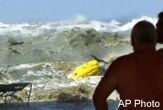Insurance Company Funds Study of East Coast Tsunami Risk

An insurance company has given $86,000 to scientists at the University of Rhode Island to study the potential damage were a large tsunami to strike the U.S. East Coast.
Researchers have focused much attention on the tsunami hazard in the Pacific, from Japan and Hawaii to the Pacific Northwest down to Los Angeles. Even the risk of a Gulf Coast tsunami has been studied.
But little attention has been paid the the Atlantic threat.
Scientists say a devastating East Coast tsunami could be spawned by an ocean impact of an asteroid or an underwater landslide triggered by an earthquake.
FM Global, one of the world’s largest commercial property insurers, commissioned the study to create maps of the East Coast that will identify potential tsunami flooding and damage.
"FEMA [the Federal Emergency Management Agency] has worked on hazard maps for the West Coast and Hawaii for years, but none have been made for the East Coast," said Stephan Grilli of the University of Rhode Island. "That’s partly because there is a lower risk for tsunamis in the Atlantic, but also because they’re more complicated to predict."
Pacific tsunamis have been recorded and studied in the past. A large one would most likely be generated by a quake that quickly raises or lowers part of the seafloor, as happened last year in the Indian Ocean.
Sign up for the Live Science daily newsletter now
Get the world’s most fascinating discoveries delivered straight to your inbox.
Tsunamis in the Atlantic Ocean are more likely to be caused by underwater landslides near the continental shelf, where the American continent suddenly drops off into the deeper ocean abyss. Predicting how large a wave this would generate is more difficult, Grilli said.
Grilli and a colleague will use existing maps to study the amount, weight, cohesiveness and slope angle of sediment on the upper slope of the continental shelf that may be unstable and could slide.
Of key interest is an area off the New Jersey coast and another on the Grand Banks off Nova Scotia, where a major tsunami was triggered in 1929.
"An earthquake with a magnitude of 6.0 isn't strong enough to cause a tsunami [by itself], but it certainly could cause an underwater landslide that could cause a tsunami," Grilli said.










